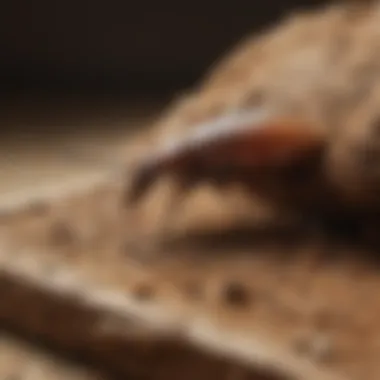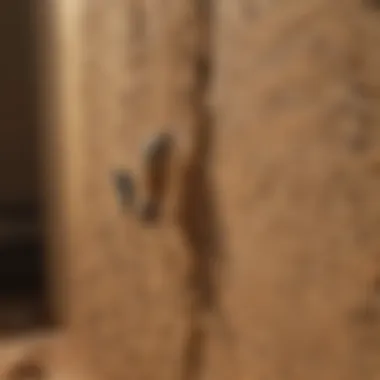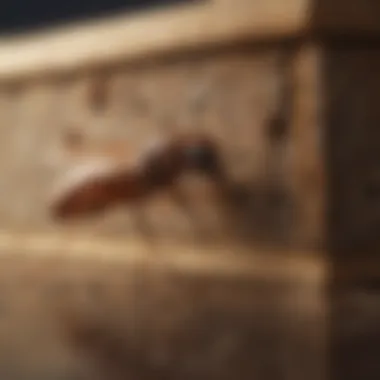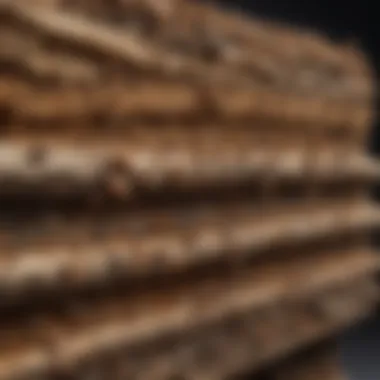Unveiling Effective Techniques to Monitor Termites for Property Preservation


Preventive Pest Control Strategies
When it comes to protecting your home from termite infestations, implementing preventive pest control strategies is paramount. Starting with the house exterior, it's essential to seal any cracks or gaps that could serve as entry points for pests. By clearing debris around your property, you eliminate hiding spots for termites and other pests. Additionally, taking measures to prevent pests from entering your home through proper sealing and maintenance is crucial.
In terms of yard maintenance, incorporating essential routines such as trimming shrubs and grass, removing standing water, and keeping vegetation away from the foundation can significantly reduce the risk of termite infestations. Maintaining a pest-free yard involves practices like regular mowing, pruning, and removing decaying wood or plant matter.
Indoor cleanliness plays a pivotal role in pest prevention. By implementing expert cleaning tips and techniques, you can create a pest-resistant indoor environment. This includes proper food storage, waste management, and sealing cracks or openings where pests could enter. Garbage disposal also plays a vital role in pest control, with efficient waste disposal methods helping to eliminate attractants for termites and other pests. Ensuring proper garbage disposal not only keeps pests at bay but also contributes to a healthier living environment. Additionally, exploring innovative ways to safeguard your home, such as utilizing natural repellents or installing ultrasonic pest repellents, can add an extra layer of protection against termite infestations.
Identifying Pest Risk Areas
To effectively combat termite infestations, it's essential to identify potential risk areas in and around your home. Conducting thorough inspections of moisture-prone areas can reveal conditions conducive to termite activity. By identifying damp conditions and implementing preventive measures such as proper ventilation and drainage, you can reduce the risk of infestations.
Inspecting crack and crevices for signs of pest activity is crucial in termite monitoring. Regular inspections and sealing of access points can help prevent termite entry. Greenery around the property also warrants inspection, as dense vegetation near the home can attract pests. Maintaining a well-groomed yard with trimmed vegetation can deter pests from nesting near the property.
Additional pest risk areas can include attics, basements, and crawl spaces, where pests often seek shelter. By addressing these areas and implementing preventive measures such as sealing openings, installing screens, or using barriers, you can minimize the likelihood of termite infestations.
Effective Pest Control Methods
In the event of a termite infestation, it's crucial to have effective pest control methods at your disposal. Natural repellents made from essentials oils or natural products can serve as eco-friendly solutions to repel pests. These repellents can be used both indoors and outdoors to create a barrier against termites without harmful chemicals.
Chemical sprays are another effective pest control method when dealing with severe infestations. Professional sprays formulated to exterminate termites can be used safely and effectively under proper guidance. Additionally, pest traps can be employed to capture and remove pests without harming the environment. By setting up traps strategically around the property, you can monitor and control termite populations.
Biological control methods involve the use of natural predators to manage pest populations in an eco-friendly manner. By introducing natural predators or beneficial insects that prey on termites, you can achieve sustainable pest control without relying on chemicals. Other innovative pest control methods go beyond traditional approaches, exploring options such as heat treatments, electrocution devices, or termite baits for targeted control.
Pest Species Identification
To effectively control termites and other pests, it's crucial to be able to identify different pest species commonly found in and around homes. Common insects like ants, cockroaches, and spiders can indicate underlying pest issues that may extend to termite infestations. By recognizing and managing these insect infestations, you can address pest problems comprehensively.
Identifying rodent species that may pose a threat to your home is also essential in pest prevention. By understanding the behavior and nesting habits of rodents like mice and rats, you can take preventive measures to safeguard your property. Birds can also impact home environments, with certain bird species causing damage or creating nuisance around residential areas. By addressing bird-related issues proactively, you can mitigate potential pest problems associated with bird populations.
Dealing with wildlife encounters on your property requires a different approach, as wildlife species can pose unique challenges in pest management. Understanding the behavior of wildlife species and implementing effective control measures can help prevent conflicts and protect your home from wildlife-related damage. Identifying and managing miscellaneous pest species effectively rounds out your pest identification knowledge, ensuring no potential threat goes unnoticed.
DIY Pest Control Techniques


For homeowners looking to take a hands-on approach to termite prevention and control, DIY pest control techniques offer practical and sustainable solutions. Homemade pest control remedies using everyday household items provide an eco-friendly alternative to chemical treatments. These DIY solutions can help protect your home without the use of harsh chemicals, promoting a safer living environment.
Using essential oils for pest control is another natural and aromatic method to keep termites at bay. Essential oils like lavender, peppermint, or neem oil can act as natural repellents against pests, creating a pleasant-smelling barrier around your home. By incorporating essential oils into your cleaning routine or diffusing them in problem areas, you can effectively repel termites and other pests.
Setting up effective pest traps and barriers is a proactive way to control termite populations without resorting to chemical treatments. By strategically placing traps along termite pathways or using physical barriers to block access points, you can intercept termites before they invade your home. Choosing top reputable pest control brands for additional support ensures that you're using quality products backed by research and efficacy. By investing in trusted pest control solutions, you can fortify your home against potential termite threats.
Exploring miscellaneous DIY pest control techniques for specific pest issues offers creative solutions to common problems. From homemade traps to natural deterrents, these DIY methods provide homeowners with versatile strategies to tackle various pest challenges effectively.
Introduction
Termite infestations can pose a significant threat to properties, silently causing extensive damage that often goes unnoticed until it's too late. This article delves into the world of termite monitoring techniques, offering a comprehensive guide to detecting and managing these destructive pests. Understanding effective monitoring strategies is vital in safeguarding your home or property from costly structural issues caused by termites. By exploring a range of innovative solutions and time-tested methods, you can gain valuable insights into protecting your investment and ensuring long-term structural integrity.
Understanding Termite Behavior
In the realm of termite monitoring techniques, delving into the behavior of these elusive pests is crucial. Understanding termite behavior forms the foundation of effective termite control strategies, as it provides insights into their habits, preferences, and vulnerabilities. By comprehending how termites operate within a given environment, property owners can proactively tailor their monitoring and prevention methods to combat infestations.
Termites are highly organized insects that operate in colonies with defined roles, including workers, soldiers, and reproductives. These complex social structures influence their foraging behavior and nesting preferences, dictating how and where they establish their colonies. Additionally, termites exhibit a preference for moisture-rich environments, making them particularly attracted to areas with high humidity levels or water leaks.
One of the key benefits of understanding termite behavior lies in early detection and intervention. By recognizing the signs of termite activity, such as mud tubes, discarded wings, or hollow-sounding wood, property owners can swiftly address infestations before significant damage occurs. Moreover, knowing the specific species of termites prevalent in a region further refines monitoring techniques, as different species may exhibit varying behaviors and responses to treatment methods.
Considerations about understanding termite behavior extend to the development of targeted treatment plans and preventive measures. By factoring in termite behavior patterns, such as foraging distances, feeding preferences, and nesting habits, pest management professionals can design customized strategies to disrupt termite activities effectively. This personalized approach maximizes the efficiency of termite control efforts, reducing the risk of recurrent infestations and property damage.
In essence, exploring termite behavior within the context of monitoring techniques serves as a linchpin for successful termite management. By illuminating the intricate dynamics of termite colonies and their interactions with the environment, property owners can implement proactive measures to safeguard their structures from potential infestations.
Physical Barriers as a Preventive Measure
In the realm of termite monitoring techniques, the utilization of physical barriers stands out as a crucial preventive measure. Physical barriers act as a primary defense against termite infestations by creating obstacles that termites cannot easily penetrate, thereby protecting structures from potential damage. By implementing physical barriers, homeowners can proactively fortify their properties and mitigate the risks associated with termite activity. These barriers serve as a deterrent, forcing termites to divert their path or exposing them to detection, thus preventing them from reaching vulnerable areas within a building.
Types of Physical Barriers
A variety of physical barriers are available for termite prevention, each offering unique advantages and functionalities. Some common types include stainless steel mesh, crushed rock particles, concrete slabs, and plastic sheeting. Stainless steel mesh provides a durable and long-lasting barrier that termites cannot penetrate, offering effective protection for structures. Crushed rock particles create a physical obstruction that termites find challenging to navigate through, acting as a barrier that deters termite intrusion. Concrete slabs function as solid deterrents against termite ingress, forming a sturdy foundation that prevents termite access to the building. Plastic sheeting acts as a moisture barrier along with a physical hindrance for termite entry, making it a versatile option for termite prevention.
Installation Process
The installation process of physical barriers involves meticulous planning and execution to ensure optimal protection against termites. Firstly, a thorough inspection of the property is conducted to identify vulnerable areas and determine the most suitable type of physical barrier to be installed. Next, the chosen barrier is installed according to specific guidelines and manufacturer instructions, taking into account factors such as soil composition, building layout, and termite activity patterns. Proper sealing and overlapping are essential during installation to eliminate potential gaps that termites could exploit. Regular maintenance and inspection of physical barriers are also crucial to ensure their continued effectiveness in safeguarding the property against termite infestations.


Chemical Treatments for Termite Control
Common Chemical Solutions
Common chemical solutions utilized for termite control encompass a range of compounds designed to target and exterminate termites. These solutions often include pesticides, termiticides, and other chemical agents tailored to combat specific termite species. Property owners can opt for soil treatments, baits, or barrier applications, depending on the extent of the infestation and the property's characteristics. It is essential to consult with pest control professionals to identify the most suitable chemical solution for the given situation.
Application Techniques
When implementing chemical treatments for termite control, correct application techniques are paramount to ensure efficacy and long-term protection. Professionals typically conduct thorough inspections to determine the extent of infestation and select the appropriate treatment method. Soil treatments involve creating a chemical barrier around the structure's perimeter, while bait stations target termite colonies directly. It is crucial to follow dosage recommendations, safety protocols, and guidelines for proper application to maximize the treatment's effectiveness and minimize potential risks.
Baiting Systems and Their Effectiveness
Baiting systems offer several benefits that set them apart from traditional chemical treatments. One of the key advantages is their low environmental impact, as they specifically target termites without widespread exposure to chemicals. Moreover, bait stations can be discreetly placed around the property, making them a visually unobtrusive option for termite management. Additionally, baiting systems provide a long-term solution by effectively eliminating the entire termite colony, thus preventing future infestations.
When considering the effectiveness of baiting systems, it is essential to factor in various considerations. Firstly, the choice of baiting system should align with the specific type of termites infesting the property, ensuring targeted elimination. Additionally, regular monitoring and maintenance of bait stations are crucial to assess their efficacy and make any necessary adjustments. Understanding the lifecycle and foraging behavior of termites is also vital in optimizing the effectiveness of baiting systems for long-term termite control.
Working Mechanism of Baiting Systems
The working mechanism of baiting systems revolves around exploiting the foraging behavior of termites to distribute toxic bait throughout the colony. Initially, bait stations containing appetizing materials are strategically placed in termites' foraging areas to attract them. Once termites discover the bait stations, they consume the toxic substance and carry it back to the nest, inadvertently sharing it with the entire colony.
The bait used in these systems is slow-acting, allowing termites to transport it to other colony members before succumbing to its effects. This ensures that the poison spreads effectively among the entire termite population, ultimately leading to the comprehensive elimination of the colony. Through the working mechanism of baiting systems, targeted termite control is achieved without the need for widespread chemical applications.
Monitoring and Maintenance
Monitoring and maintenance play a pivotal role in ensuring the ongoing effectiveness of baiting systems. Regular inspections of bait stations are necessary to assess bait consumption levels and determine if additional bait is required. Monitoring also allows for the identification of any changes in termite activity, enabling prompt responses to fluctuations in infestation levels.
Maintenance of baiting systems involves replenishing bait as needed, replacing damaged stations, and adjusting placements based on monitoring data. By consistently monitoring and maintaining bait stations, property owners can safeguard their structures against termite infestations and proactively manage termite populations. With vigilant monitoring and meticulous maintenance, baiting systems can serve as a reliable and efficient method for long-term termite control.
Moisture Control for Termite Prevention
Moisture control is a critical aspect of termite prevention strategies explored in this comprehensive guide on termite monitoring techniques. Termites are attracted to moisture-rich environments, making effective moisture control key to safeguarding properties from potential infestations. Excess moisture can create conducive conditions for termites to thrive and proliferate, emphasizing the significance of proactive moisture management techniques.
Significance of Moisture Levels


Maintaining optimal moisture levels within and around structures is pivotal in deterring termite activity. High moisture content in wood and soil increases the attractiveness of a property to termites, signaling an invitation for potential infestation. Understanding the correlation between moisture levels and termite activity is essential for preemptive measures against termite infestations. Monitoring and regulating moisture content serve as proactive steps in mitigating the risk of termite attacks.
Effective Moisture Management
Employing effective moisture management strategies involves a multifaceted approach to controlling moisture sources and repairing any leaks or damp areas promptly. Regular inspections to identify and address moisture issues, such as leaky pipes, improper drainage, or faulty seals, are imperative in preventing termite attraction. Implementing proper ventilation, drainage systems, and moisture barriers can significantly reduce the risk of termite infestations. Additionally, maintaining well-ventilated crawl spaces and ensuring proper grading around the foundation can help mitigate moisture accumulation, creating an unfavorable environment for termite colonization.
Advanced Termite Monitoring Technology
In the realm of termite control, Advanced Termite Monitoring Technology plays a crucial role in enhancing detection and management strategies. This section delves into the technological innovations that have revolutionized how termite infestations are monitored and addressed. By incorporating cutting-edge tools and methodologies, professionals can significantly increase the efficiency and effectiveness of termite control measures. Advanced Termite Monitoring Technology encompasses a range of sophisticated approaches that go beyond traditional methods, offering accurate and timely insights into termite activity within a property.
Use of Thermal Imaging
Thermal imaging has emerged as a game-changer in termite detection, allowing pest control experts to identify termite presence through heat signatures. This innovative technology utilizes infrared cameras to detect temperature variations that indicate the presence of termites within structures. By highlighting anomalies such as temperature variations in walls or floors, thermal imaging enables early detection of termite colonies that may otherwise remain concealed. Additionally, thermal imaging provides a non-invasive way to inspect for termites, minimizing disruption to property owners while ensuring comprehensive monitoring of termite activity.
Sensor-Based Termite Detection
Sensor-based termite detection systems leverage advanced sensors to detect termite activity in real-time, offering continuous monitoring and early detection capabilities. These systems are designed to detect changes in environmental conditions associated with termite presence, such as fluctuations in humidity or temperature. By automatically sensing and alerting to potential termite activity, sensor-based detection systems enable prompt intervention to mitigate infestations before significant damage occurs. Moreover, these technologies provide property owners with valuable insights into termite behavior patterns, aiding in the development of targeted control strategies for long-term termite management.
Integrated Pest Management Approaches
In the realm of termite monitoring techniques, Integrated Pest Management (IPM) approaches emerge as a pivotal component in ensuring effective termite control and prevention. Unlike singular methods, IPM encompasses a comprehensive strategy that integrates various tools and practices to address pest issues holistically. This multifaceted approach emphasizes sustainable and environmentally friendly solutions to manage termite infestations.
Importance of Integrated Pest Management Approaches
One key element underscoring the importance of IPM approaches in this article is its focus on long-term termite control rather than short-term fixes. By combining biological, cultural, physical, and chemical control methods tailored to specific pest concerns, IPM aims to minimize pesticide usage while maximizing efficacy. This strategic blend not only targets existing termite colonies but also prevents future infestations through proactive measures.
Benefits of Integrated Pest Management Approaches
The benefits of adopting IPM approaches in termite monitoring are manifold. Firstly, it promotes a sustainable ecosystem by fostering natural termite predators and competitors, reducing the reliance on chemical treatments. Secondly, IPM enhances the overall health and integrity of structures by implementing strategies that fortify barriers against termite intrusion. Moreover, by customizing solutions based on site conditions and pest pressures, IPM ensures a tailored and targeted approach for efficient termite management.
Considerations about Integrated Pest Management Approaches
When delving into the realm of Integrated Pest Management, certain considerations come to the forefront. The adaptability of IPM strategies to diverse environments underscores its versatility in various settings, be it residential, commercial, or agricultural. Additionally, the knowledge and expertise required to implement IPM successfully highlight the importance of engaging professionals well-versed in integrated pest management practices. Furthermore, ongoing monitoring and assessment are crucial components of IPM, ensuring that strategies are continually refined to maintain optimal effectiveness.
Conclusion
One of the specific elements to consider in this conclusion is the emphasis on integrated pest management approaches. By integrating different strategies such as physical barriers, chemical treatments, baiting systems, moisture control, advanced monitoring technology, and more, a cohesive and comprehensive termite prevention plan can be formulated. This holistic approach not only enhances the effectiveness of termite control but also reduces the reliance on any single method, thereby improving long-term sustainability.
Furthermore, the conclusion delves into the benefits of proactive termite monitoring. Detecting termite activities early on allows for prompt intervention, preventing extensive damage to structures and reducing costly repairs. By staying informed about termite behavior and continually monitoring for any signs of infestation, homeowners can safeguard their properties and maintain peace of mind.
Considerations about the conclusion also include the adaptive nature of termite monitoring techniques. As termites evolve and adapt to different environmental conditions, regular assessment and adjustments to monitoring strategies become crucial. The conclusion stresses the importance of staying up-to-date with the latest advancements in termite control to effectively combat these resilient pests.



